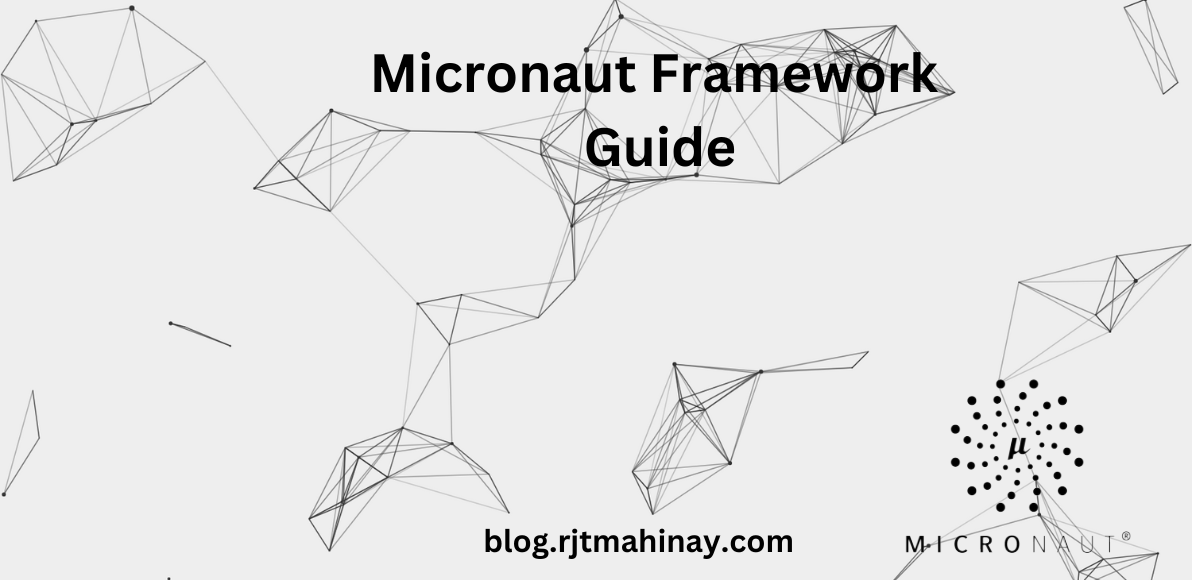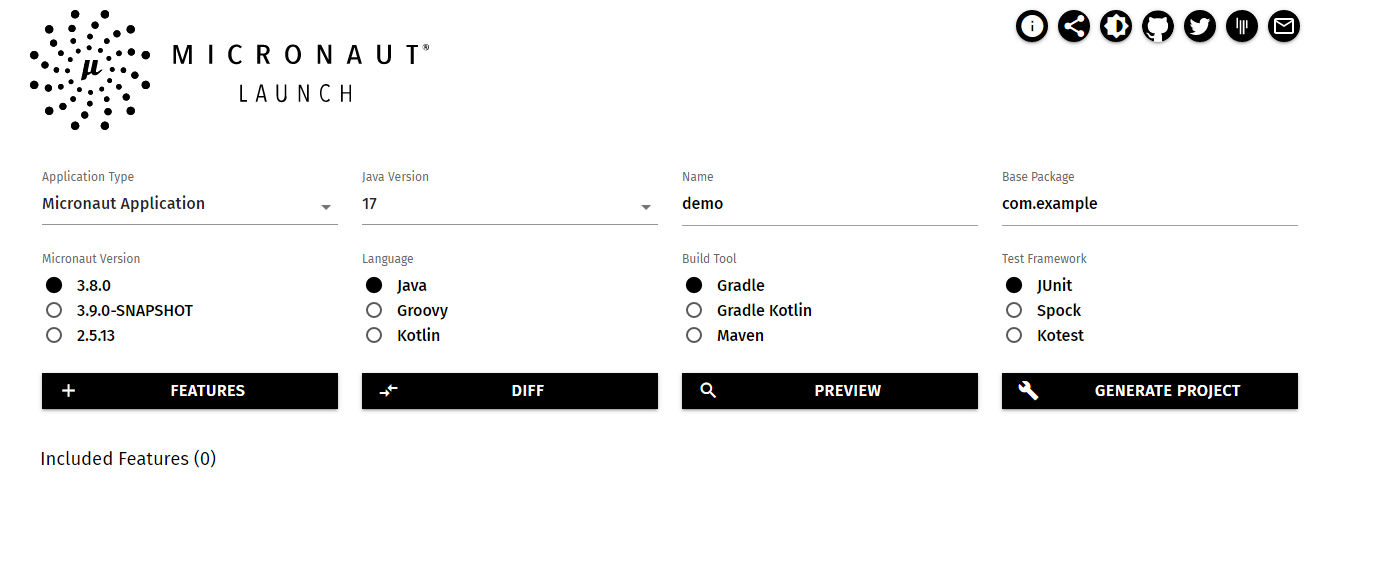Micronaut: Yet Another Java Framework
 Tristan Mahinay
Tristan Mahinay
Introduction
With the rise of application modernization in the cloud, Java position itself by having different frameworks that can produce lightweight applications in the cloud to minimize memory consumption and quick application start-up.
In this post, I'm gonna explain the codes presented in my demonstration:
What is Micronaut?
Micronaut is a full-stack framework for building microservice and serverless applications. It leverages the use of compile-time inversion of control that results in quick start-up and low memory footprint.
Significant features of this framework to others like Spring Boot:
Reduced Memory Footprint
Quick startup time
Minimal use of runtime reflection and proxies
Leverages AOT (Ahead of Time) compilation
Doesn't depend any more to the size of the codebase
As of the writing, the version of Micronaut is 3.8.0. Also, Micronaut's annotation design is very similar to Spring Boot. Thus, a minimal learning curve for Spring Developers 😁
👨🏻💻 Create your application!
To create a Micronaut application, you can create it via CLI or the Launcher site.
CLI
You can start by downloading Micronaut CLI here. After installing you can create your app using the command below:
mn create-app example-app --features <additional dependencies>
the --features option lets you add dependencies other than the Micronaut native features. After creating the app a micronaut-cli.yml file is created where it shows the information about the project you've created. Below is an example of the contents of the YAML file.
applicationType: default
defaultPackage: com.rjtmahinay
testFramework: junit
sourceLanguage: java
buildTool: gradle
features: [annotation-api, app-name, data, data-jpa, gradle, h2, http-client, jackson-databind, java, java-application, jdbc-hikari, junit, logback, micronaut-build, netty-server, openapi, readme, shade, swagger-ui, yaml]
Micronaut Launcher
In this approach, you will be shown a user interface to create your Micronaut application with ease. The launcher can be found here

As you can see the launcher design used is familiar to us and is also similar to Spring Initialzr's website. You can see that it has a feature button where you can add your project's dependencies. A preview is also shown for you to have a glimpse of what files are created. When generating your project either you can download the file or push it to a GitHub repository.
👨🏻💻 Let's start coding!
The main entry application of Micronaut will be a class that invokes the Micronaut class. Below is a simple entry code to run the application.
public class Application {
public static void main(String[] args) {
Micronaut.run(Application.class, args);
}
}
If you want to access the different arguments that you can pass to Micronaut's application context. You can use the builder approach.
public class Application {
public static void main(String[] args) {
Micronaut.build(args)
.mainClass(Application.class)
.eagerInitSingletons(true)
.start();
}
}
Creating a Bean
In Micronaut you can create your beans inside a configuration called Factory. This factory class will load your specified beans. It is the counterpart of Configuration in Spring. Below are some used annotations for bean creation.
@Factory // The configuration annotation to create your beans
public class ApplicationConfiguration {
@Singleton // Create a single instance of a bean
public EmployeeBean singletonBean() {
return new EmployeeBean();
}
@Bean // Create a copy of bean for every invocation
public EmployeeBean bean() {
return new EmployeeBean();
}
@Prototype // Similar to @Bean
public EmployeeBean prototypeBean() {
return new EmployeeBean();
}
@Context // Create a bean upon start of ApplicationContext
public EmployeeBean contextBean() {
return new EmployeeBean();
}
}
Autowire a bean
In Spring we use the Autowired annotation but in Micronaut it leverages the use of Inject of jakarta annotations library.
@Inject // Autowires your bean in the ApplicationContext
private EmployeeBean singletonBean;
Creating Properties
Just like in Spring Boot, we want to configure our custom property class. It uses the same syntax in Spring called ConfigurationProperties
// The value of the annotation is the name of your property
@ConfigurationProperties("example")
public class EmployeeProperties {
private String value;
}
You can also get the value directly
// Using an expression language, you can get the value of a property
@Value("${example.value}")
private String value;
Define your DTO
You can use a DTO to map your JSON request and pass it to persistence layer model. Here we encounter the annotations Serdeable and Introspected.
In Java 17, you can now use records as your request/response model. This removes the use of Lombok library for most cases.
Other annotations like NotEmpty and DecimalMin are part of javax validations.
@Serdeable // Used for JSON serialization
@Introspected // Used for introspecting your beans in compile-time
public record EmployeeDto(@JsonProperty @NotEmpty String name, @JsonProperty String address, @JsonProperty String position, @JsonProperty @DecimalMin("1.0") BigDecimal salary) {
}
The Persistence Layer
The persistence layer is composed of the repository and its entity. The library used is the Micronaut Data JPA
Define your entity
Defining your entity is similar to using the basic JPA format where you initialize it using Entity and Table. The difference here is you must annotate your class using Serdeable for compile-time serialization.
@Serdeable // Used for compile-time serialization
@Setter
@Getter
@Entity // Defines your class as a database entity
@Table(name = "EMPLOYEE") // Annotation to map the class as your table
public class Employee {
@Id
@GeneratedValue(strategy = GenerationType.AUTO)
@Column(name = "ID", nullable = false, insertable = false, updatable = false)
private Long id;
@Column(name = "NAME")
private String name;
// Removed other attributes for brevity
}
Define your repository
Micronaut supports Synchronous and Reactive repositories. These can be extended by the following interfaces. The annotation is similar to Spring's repository.
@Repository // Used for defining the class as repository
public interface SynchronousEmployeeRepository extends JpaRepository<Employee, Long> {
@Query("SELECT e FROM Employee e") // Use to define your own query
List<Employee> findAllEmployee();
}
Below can return a type of Reactor's Flux (for list and streams) or Mono (single object).
@Repository // Used for defining the class as repository
public interface ReactiveEmployeeRepository extends ReactorCrudRepository<Employee, Long> {
@Query("SELECT e FROM Employee e") // Use to define your own query
Flux<Employee> findAllEmployee();
}
The Service Layer
The concept of the service layer is mostly used in the time of Monolithic Architecture which uses the MVC Design Pattern. Although there is no Service annotation in Micronaut, you can use the existing Singleton to create your service. After all, services are used as beans.
public interface SynchronousEmployeeService {
Optional<Employee> getEmployee(Long id);
// Removed other functions for brevity
}
@Singleton // Make your service as a bean
public class SynchronousEmployeeServiceImpl implements SynchronousEmployeeService {
@Inject
private SynchronousEmployeeRepository synchronousEmployeeRepository;
@Override
public Optional<Employee> getEmployee(Long id) {
return synchronousEmployeeRepository.findById(id);
}
// Removed other logic for brevity
}
The Controller Layer
This consists of your API definitions in Micronaut. It is similar to Spring's Controller but the difference is you need an additional RestController for your return type to be serialized. In Micronaut, it is already done by one annotation.
// Used for making the API managed by Micronaut threading
@ExecuteOn(TaskExecutors.IO)
// The controller annotation with the define root URI
@Controller("/v1/synchronous/employee")
public class SynchronousEmployeeController {
// Removed logic for brevity
}
GET
This will return a serialized response and may be used using a Query Parameter or Path Parameter. Notice that you don't need an extra annotation for defining a Path Parameter, Micronaut already handles it.
@Get(uri = "/{id}", produces = MediaType.APPLICATION_JSON)
public Optional<Employee> getEmployee(Long id) {
return employeeService.getEmployee(id);
}
POST
This will invoke an add operation to your persistence layer and custom response. The additional Body annotation can be optionally removed since Micronaut knows that it is your request body. The Valid annotation asserts that your request body should be validated.
@Post(uri = "/add", consumes = MediaType.APPLICATION_JSON, produces = MediaType.APPLICATION_JSON)
public Employee createEmployee(@Body @Valid EmployeeDto employeeDto) {
return employeeService.addEmployee(employeeDto);
}
PUT
This will invoke an update to your data. In the case of combining a Path Parameter and Request Body. You can define it using PathVariable (similar to Spring) and Body.
@Put(uri = "/update/{id}", consumes = MediaType.APPLICATION_JSON, produces = MediaType.APPLICATION_JSON)
public Employee updateEmployee(@PathVariable Long id, @Body @Valid EmployeeDto employeeDto) {
return employeeService.updateEmployee(id, employeeDto);
}
DELETE
This will invoke a deletion of your data.
@Delete(uri = "/delete/{id}", consumes = MediaType.APPLICATION_JSON, produces = MediaType.APPLICATION_JSON)
public String deleteEmployee(Long id) {
employeeService.deleteEmployee(id);
return "Successfully deleted";
}
Caching
Sometimes you want to put a cache for method calls in your API. This is usually applied to your API methods. This can be done in Micronaut using the annotations below.
// Stores the data in the specified cache name
@CachePut("synchronous-employee")
// Invalidates all the stored cache by name
@CacheInvalidate("synchronous-employee")
Exceptions
Handling exceptions in Micronaut can be done using the Error annotation or the custom one. Below is a method defined in a controller.
@Error
public HttpResponse<JsonError> error(HttpRequest<?> request, Throwable e) {
JsonError error = new JsonError("Exception in Synchronous Controller: " + e.getMessage())
.link(Link.SELF, Link.of(request.getUri()));
return HttpResponse.<JsonError>serverError()
.body(error);
}
If you want it to be used in all controllers, just set a value of global=true in the annotation.
@Error(global = true)
public HttpResponse<JsonError> error(HttpRequest<?> request, Throwable e) {
// your logic
}
You can also create your custom exceptions. Here it states that it requires an EmployeeException to invoke.
@Singleton
// Equivalent annotation of @ConditionalOn*** in Spring
@Requires(classes = EmployeeException.class)
public class EmployeeExceptionHandler implements ExceptionHandler<EmployeeException, HttpResponse<?>> {
@Inject
private ErrorResponseProcessor<?> errorResponseProcessor;
@Override
public HttpResponse<?> handle(HttpRequest request, EmployeeException exception) {
return errorResponseProcessor.processResponse(
ErrorContext.builder(request)
.cause(exception)
.errorMessage("Handled by custom handler").build(),
HttpResponse.badRequest());
}
}
For this to work, you must disable the HTTP Client Exception property.
micronaut:
http:
client:
exception-on-error-status: true
👨🏻💻 Running the application
You can run the application using the build management tool. For this demo, I've used Gradle as my build management tool. You can run your newly created application via the command below:
./gradlew run
After running you can see that the startup time of Micronaut is as twice low as Spring Boot. This is the power of Ahead of Time compilation.

Micronaut supports docker build images in Gradle Plugin which you can use
For standard docker image
./gradlew dockerBuild
For GraalVM Native Image
./gradlew dockerBuildNative
💭 Final Thoughts
Micronaut is a promising microservice and serverless framework in the Java space. It leverages the use of compile-time inversion of control with very minimal reflection. We want a lightweight and quick startup time application when deploying to the cloud. If you're creating a new service in your organization, Micronaut will be one of the good choices.
📝Further Reading
Check out the Micronaut's documentation for more information
Subscribe to my newsletter
Read articles from Tristan Mahinay directly inside your inbox. Subscribe to the newsletter, and don't miss out.
Written by

Tristan Mahinay
Tristan Mahinay
Tristan Mahinay is a software engineer currently focusing on building and architecting scalable back-end systems using Java and different cloud platforms in a Containerized Architecture. Most of his time is dedicated to read technical books, coding in free time and contribute to open source. He also contributes as a technical SME to the IBM Java area.